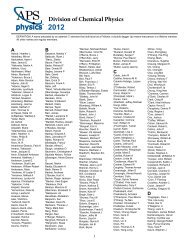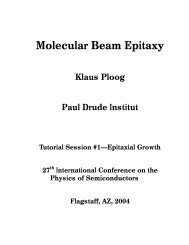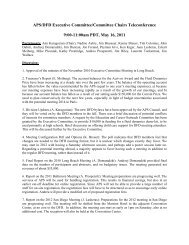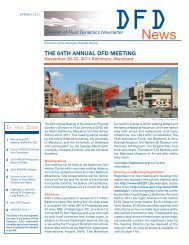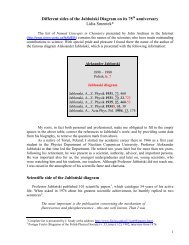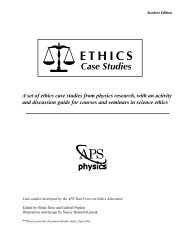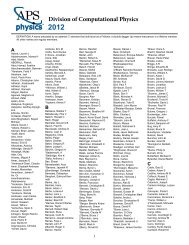The Physics of LASERs - American Physical Society
The Physics of LASERs - American Physical Society
The Physics of LASERs - American Physical Society
You also want an ePaper? Increase the reach of your titles
YUMPU automatically turns print PDFs into web optimized ePapers that Google loves.
Teacher Edition Lesson 2: How Does a LASER Work?<br />
Guidelines for variable settings:<br />
28<br />
• Use the Multiple Atoms (Lasing) tab<br />
• Select three energy levels<br />
• Maximize level two’s lifetime<br />
• Match lamp output energy to energy between<br />
levels three and one<br />
• Enable mirrors, and set mirror reflectivity to<br />
96%<br />
• Adjust slider for lamp intensity so that level<br />
two’s population is maximized<br />
Image credit: PhET Interactive Simulations, University <strong>of</strong><br />
Colorado, http://phet.colorado.edu<br />
Image credit: PhET Interactive Simulations, University <strong>of</strong><br />
Colorado, http://phet.colorado.edu<br />
Part B, Step 3<br />
An easy way to achieve this is to have the same laser<br />
settings as those that worked for Step 2, but now<br />
make both mirrors 100% reflective.<br />
Part B, Step 4<br />
Students should indicate that an energy source is<br />
needed to initially excite atoms that make up the active<br />
laser medium. <strong>The</strong> active medium transforms<br />
the incident input energy into the laser output light<br />
energy. Mirrors are needed to collimate this light<br />
energy and allow it to build up. From the PhET<br />
simulator students should recognize that the active<br />
medium is composed <strong>of</strong> atoms. <strong>The</strong> atom’s energy<br />
levels used in the lasing process must have a long<br />
enough lifetime to allow for stimulated emission to<br />
<strong>The</strong> <strong>Physics</strong> <strong>of</strong> <strong>LASERs</strong>, Teacher Edition<br />
Student Edition Lesson 2: How Does a LASER Work?<br />
B. What conditions do you need to get the Phet simulator laser to work?<br />
You are going to try to get the PhET simulator to lase (produce laser light). You will<br />
need more than one atom, so use the PhET simulator with the multi-atom tab selected.<br />
1. With your group decide on your procedure to make this computer model <strong>of</strong> a laser<br />
work (lase). List all <strong>of</strong> the variables. For each one determine an initial setting, and<br />
why you chose it.<br />
2. As you go through your procedure, record your observations. How do the variables<br />
you change affect the lasing process? Record any changes you make and why you<br />
made them.<br />
3. What could you do to get the PhET simulator into the danger zone? (See the laser<br />
power indicator). Watch out, the laser could blow up!<br />
4. What conditions do you need to get a laser to work? Using what you have learned<br />
from the PhET simulator, describe how you could make a working laser.<br />
Student Version Page 10<br />
occur. Students might have a sense that it is easier for this process to<br />
occur with multi-level atoms making up the active medium.<br />
Did students reach the goal <strong>of</strong> Part B? Students should have adjusted<br />
the variables in the PhET simulator using the multi-atom, threelevel<br />
settings, to obtain the lasing process. <strong>The</strong>ir answer in Part B,<br />
Step 4 should describe the conditions they needed to get the PhET<br />
simulator to lase.<br />
Image credit: PhET Interactive Simulations, University <strong>of</strong><br />
Colorado, http://phet.colorado.edu<br />
<strong>The</strong> <strong>Physics</strong> <strong>of</strong> <strong>LASERs</strong> 11




